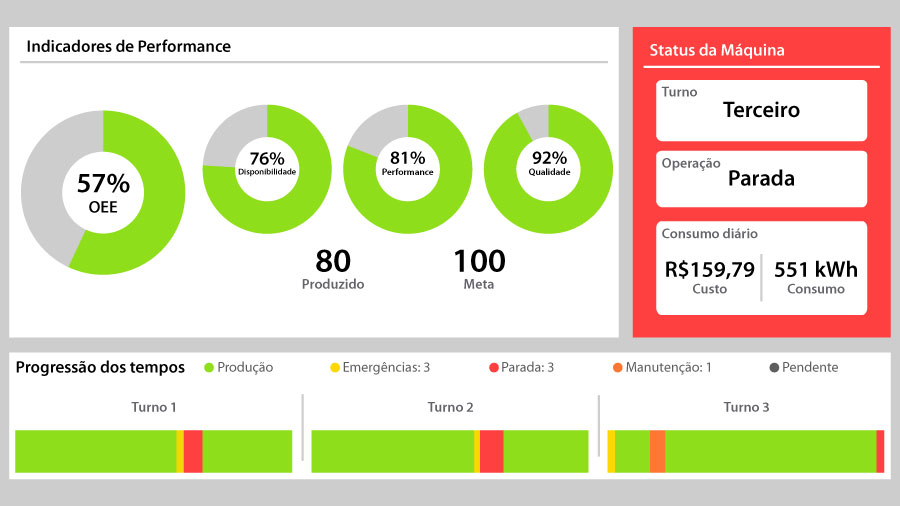Increasingly used in different industry segments, OEE is an excellent resource for measuring the performance level of your equipment and applications. Working together with the philosophy of lean manufacturing, the index is directly related to process improvement practices and actions. In the next paragraphs, you will be able to understand in detail what it is for and how to calculate OEE indicators for your operation.
What is OEE?
Acronym in English for Overall Equipment Effectiveness, OEE is a concept developed by Japanese author Seiichi Nakajima, considered the creator of TPM (Total Productive Maintenance). The methodology is used to calculate the difference between the production capacity of a piece of equipment and the activity rate it actually delivers. In other words, it calculates how many items with the quality desired by the operator the equipment produced in a given period of time, compared to its total production capacity.
With this index it is possible to know how much of the available time was actually spent on manufacturing the parts. This calculation helps to translate the business performance index, measuring its production capacity. The resource also helps reduce waste and increase machine performance, improving operation.
What are the OEE indicators?
As may have already become clear, the objective of the OEE methodology is to increase the productivity of an industry and reduce maintenance costs and investments by calculating the operation's performance. To reach the expected result, this calculation is made based on three main indicators: availability, quality and performance.
Availability
This indicator corresponds to the amount of working time of a piece of equipment or set of equipment and the period that it was available for use. Outages must be considered and may be due to two factors:
- Planned downtime – downtime scheduled and carried out in advance, such as predictive maintenance, cleaning or inactive days, such as weekends and holidays;
- Unplanned stops – stops resulting from unforeseen events, such as broken parts, shortage of raw materials, power outages or absence of an operator.
Unmatched Performance
This indicator is directly linked to the production rate of the machine or equipment. It provides data on the manufacturing speed of a given item, comparing it with the expected level of agility. Shorter production cycles and variations in processes can make measurement difficult. Therefore, the calculations must be precise, so that the determination of the production cost is accurate.
Quality
The quality indicator is used to measure the quantity of items produced in accordance with the expected standard and those that are defective and cannot be delivered to the customer. This is a fundamental control indicator in processes that require constant operation, such as series production. The high volume of items outside the expected quality standard is a sign that something needs to be corrected.
How to calculate the OEE index?
The calculation to arrive at the OEE index is relatively simple. Let's understand through a practical example using the three indices. The calculations used are below:
- Availability% = (Producing time / Scheduled time to produce) * 100%
- Performance% = (Actual Production Quantity / Theoretical Production Quantity) * 100%
- Quality% = (Quantity of Good Items / Total Quantity Produced) 100%
- OEE% = Availability% * Performance% * Quality%
Let's suppose that a company operates in a regime of 3 sequential shifts of 8 hours per day and that, in each shift, one of its machines operates for 7 hours and is out of operation for 1 hour, totaling 21 hours of operation per day.
Now, imagine that, on a given day, this machine worked for only 16 hours due to unscheduled stops, such as a power outage. Making the relationship between the two variables that we have available, we can calculate the Availability indicator by making the relationship between the time produced (16h) and the time programmed to produce (21h) of the machine. Availability Indicator: 4pm/9pm = 76%.
To continue with the example, let's assume that during these 16 hours of operation the same machine has the capacity to produce 100 items. However, due to the low processing speed, it ends up manufacturing only 80 items, a volume that corresponds to 13 hours of work. With this new information, we can calculate the Performance indicator by making the relationship between the quantity of actual production (13h) and the quantity of theoretical production of the machine (16h). Performance indicator: 1:16 pm = 81%.
At the end of the production regime, it was found that 8 of the 80 items produced in this period ended up failing the quality tests, which corresponds to 1 hour of work. With this data in hand, we can calculate the machine's Quality indicator, making the relationship between the time spent on producing the total number of good items (12h) and the time spent on the total quantity produced (13h). Quality indicator: 12:13 pm = 92%.
Considering the values of the three indicators, we can calculate the OEE Index by multiplying the three indicators. Machine OEE index: 76% x 81% x 92% = 57%.

Webinar OEE indicators for industry
Next Thursday, March 17th, at 10am, we will have Altus' first online event in 2022, the webinar OEE Indicators for Industry. During the meeting, our product experts Nicolas Nunes and Rodrigo Becker will bring you more details about the methodology and demonstrate how the Nexto Xpress PLC can be applied together with SCADA BluePlant to create a complete OEE solution.
Participate in the event and see how an OEE solution can improve performance and give more dynamism to your business decision-making. Click here to register!

Optimize the performance of your machines and processes
To conclude, we can state that OEE indicators are an increasingly important KPI to increase the productivity and general efficiency of an industry. Through them it is possible to verify a series of measures that can be taken to improve the productivity of the company as a whole.
If you want to apply the methodology to your processes to improve your business performance, we can help you. Fill out the form below to inform your interest and one of our experts will then get in touch.












